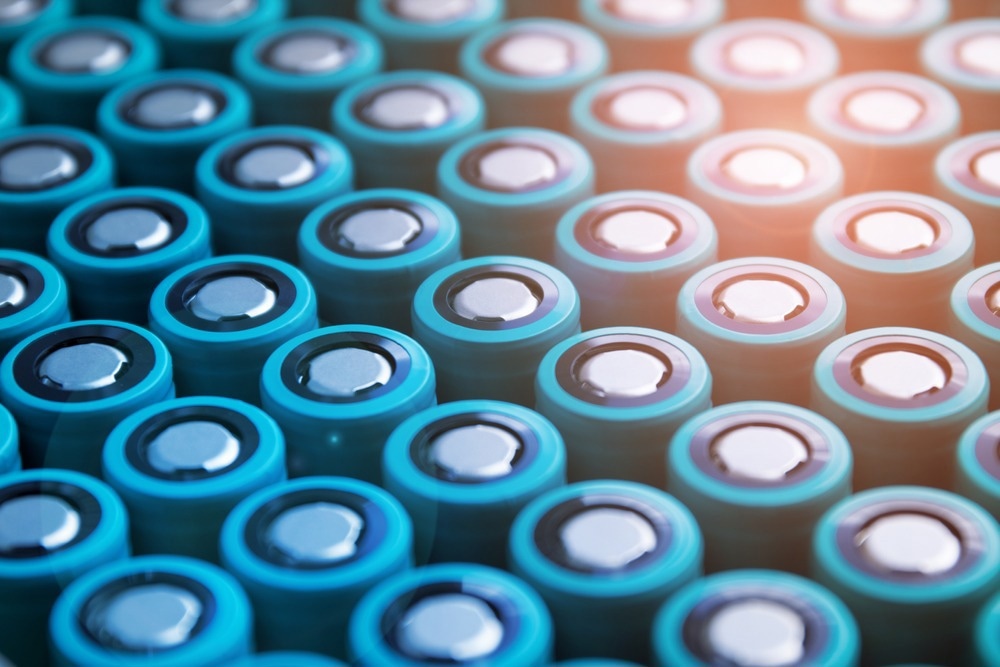A new paper in the journal Advanced Science has explored the development of a novel energy dissipative binder to improve the performance of lithium-ion battery anodes. The research has been conducted by scientists from Xi’an Jiaotong University and the China University of Geosciences.

Study: An Energy Dissipative Binder for Self-Tuning Silicon Anodes in Lithium-Ion Batteries. Image Credit: P5h/Shutterstock.com
Background to the Research
Lithium-ion batteries are a key green energy storage technology in the 21st Century. Along with fuel cells and supercapacitors, they offer the potential to overcome the environmental issues caused by over-reliance on fossil fuels and help the world transition to a post-carbon, emission-free economy.
Amongst the main components of lithium-ion batteries (and other types of battery technology), the rational design of anodes is key to ensuring their optimal performance. Several materials have been explored for use in battery anodes, with silicon emerging in research as one of the most promising ones. This is due to high specific capacity at room temperature, the low operating voltages of silicon, and resource abundance.
Whilst the beneficial properties of silicon for anode materials is well documented, there are still some key issues that further hinder practical applications. These include potential pulverization of silicon particles by extreme, repeated volume changes, incompatible SEIs, electrical contact loss, and consequent rapid decay in capacity.
Developing highly efficient silicon anodes with optimal stability and cycling life is a complex undertaking that requires the rational design of the component’s nanostructured architecture. Currently, research has focused on the discovery of suitable electrolytes and binders that can fully exploit the benefits of silicon anodes in batteries. Even a small proportion of the appropriate binder in the electrode can have remarkable results.
The binder’s mechanical properties are central to determining the cycling stability of silicon anodes and depend upon the binder’s molecular configuration as well as interactions within the binder network. The network can be modified by various routine approaches to fine-tune the binder’s properties, such as grafting, mixing, and cross-linking.
Differently tailored networks produce binders and electrodes with different properties. For instance, tough, rigid polymeric networks exhibit enhanced strength but cannot withstand damage due to their insufficient toughness, whilst highly elastic networks can adapt sufficiently to volume changes but lack the necessary ductility for energy dissipation.
Designing binder networks with the optimal combination of mechanical properties is extremely desirable in this field and therefore requires thorough investigation to improve the performance and commercial viability of silicon anodes.
One particular area of interest currently is the rational design of binders, which can improve the self-healing abilities of silicon anodes. This can be achieved via the introduction of reversible chemical bonds into the binder network.
The Study
The paper in the journal Advanced Science introduces a novel multifunctional binder for silicon lithium-ion battery anodes with comprehensive properties. The binder developed in the research is termed GCA13. An organic-based polymeric binder, it is constructed from guar gum and citric acid small molecules.
The choice of raw materials allows the co-engineering of the binder by both long-range and short-range effects, with the former effect being provided by the guar gum’s polymeric backbone, whilst citric acid provides the latter. The citric acid molecules are plasticized, enhancing the proposed binder’s viscoelastic properties.
The proposed binder overcomes the volume change problems in silicon anodes by imparting self-tuning abilities, allowing self-rearrangement in the silicon networks, meaning that electrodes maintain their structural stability during cycling. Consequently, the stability of electrode interfaces is significantly enhanced due to improvements in mechanical properties provided by the GCA13 binder.
During cycling, any cracks that appear, which would otherwise lead to silicon particle disintegration and long-term electrode instability, are healed, and the structure is reorganized. A malleable double-layer solid electrolyte interface is formed, enhancing the electrode’s energy dissipation performance and imparting superior electrochemical stability.
Outstanding capacity retention after 740 cycles was observed in silicon anodes incorporating GCA13, with extended applications over a wide range of temperatures from -15 to 60oC.
In Summary
The paper has demonstrated the rational design and green synthesis of a novel guar gum/citric acid binder for use in silicon anodes to improve their self-tuning properties, self-healing properties, and cycling performance. Anodes incorporating the GCA13 binder display noteworthy performance over a wide range of operating temperatures.
The authors have stated that due to structural and interfacial stabilization, the unique energy-dissipating viscoelastic binder can contribute to the development of high-performance, stable, advanced lithium-ion batteries with improved safety and extended lifecycles. Additionally, the sustainability of silicon resources will significantly improve the environmental friendliness of lithium-ion batteries in the future.
More from AZoM: How are Bacteria Used in Materials Development?
Reference and Further Reading
Tong, Y et al. (2022) An Energy Dissipative Binder for Self-Tuning Silicon Anodes in Lithium-Ion Batteries Advanced Science [online] onlinelibrary.wiley.com. Available at:
Disclaimer: The views expressed here are those of the author expressed in their private capacity and do not necessarily represent the views of AZoM.com Limited T/A AZoNetwork the owner and operator of this website. This disclaimer forms part of the Terms and conditions of use of this website.